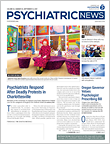A special pleasure of being your president is receiving many of the books newly published by APA Publishing (formerly known as American Psychiatric Publishing Inc., or APPI). About once a quarter, I come home to find a heavy cardboard box containing several books that give off that fresh, just-published smell and crackle as I rifle through the pages. Receiving these collections imparts a certain responsibility (I am trying not to say guilt) to read, absorb, and retain the knowledge developed or collected by experts on critical issues in the modern practice of psychiatry because I know I am getting reliable and comprehensive information reflecting what is likely to be enduring content in our field. They complement the research published in our APA journals, which typically provide a snapshot of specific areas of investigation and provide summative case reviews and commentaries.
As I write this article, I am on a flight headed to the West Coast to the “other” Washington and am now east of the Rockies. I brought along the APA Practice Guidelines for the Psychiatric Evaluation of Adults, Third Edition, to read on the flight. I try to manage air time as “found time” to be used for the luxury of reading what I want to read, not what I need to read.
With regard to the new practice guidelines, I am particularly interested in two topics: suicide assessment and trauma history. Recently there have been mandates or calls for requiring the explicit inclusion of routine screening and history taking of trauma and suicide in medical settings. The notion is that too many clinicians miss important indicators of suicide and do not routinely target either suicidal or trauma history as a factor in diagnosis and/or treatment. What do our APA practice guidelines say about these areas? Are our recommendations establishing the standards for our profession and related behavioral health professions?
First, I am reminded in the introduction that this edition (as well as other APA practice guidelines) reflects the National Academy of Sciences (NAS) standards for practice guidelines produced by professional organizations. Adhering to the NAS standards gives our members as well as the broader field of medicine and payers a high degree of confidence that the recommendations are rigorous. That we as a medical association are able to deliver high-quality practice guidelines is important because no one knows our field and our patients more intimately than we do—we are the ones on the front lines of providing evidence-based care and observing and measuring outcomes. APA’s Board of Trustees will soon be discussing at greater length the importance of investing in a process that will allow us to develop new guidelines and review already existing guidelines on a much faster turnaround basis. We cannot let the regulators or payers step in and do this for us instead. My thanks goes to Laura Fochtmann, M.D., who does much of the writing of our practice guidelines project and also to current and past members of the Steering Committee on Practice Guidelines.
With regard to suicide, our guidelines for diagnostic assessment are inclusive and not as prescriptive as some advocates would prefer. Clearly suicide assessment should be a core element of every psychiatric diagnostic evaluation. Our guidelines recommend a review of the patient’s current thinking, history of attempts and self-injury, psychosocial stressors, aggressive or psychotic ideas, and access to means, among numerous other factors. The guidelines caution against relying strictly on suicide screening tools (although they can be very helpful) and note that people presenting for psychiatric evaluation and management are at a very high risk so that suicide should always be at the forefront of assessment and reassessment.
With regard to trauma history, our guidelines are inclusive and clear without being prescriptive with detailed standards. The use of a highly structured trauma screening or assessment tool is not specifically recommended. Clearly, we are all aware that many people with psychiatric conditions who present for psychiatric evaluation and management are likely to have experienced childhood trauma, adverse life events, and adult trauma and abuse. It is critical to include a clear understanding of trauma and adverse childhood events in assessments as well as treatment plans.
Now west of the western slope of the Rockies, I am reassured that our guidelines are reasonable, responsible, evidence based, and thorough without being unnecessarily prescriptive. Thank you to all our members and staff who have been involved in developing the many practice guidelines that have been published to date or are now under development.
As I close the book, the gongs are ringing and the attendants are preparing us for landing—tray tables up, seat backs straight, and electronic devices off or in airplane mode. Seattle, here we come. ■

